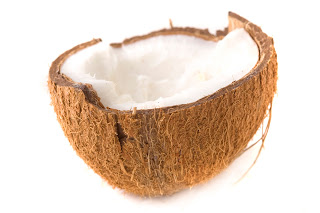Coconut flour is becoming increasingly common in gluten-free baking. (Just ask Kelly over at The Spunky Coconut, or the folks over at Gluten-Free Bistro, who use coconut flour in their GF Bistro Flour Blend…) The coconut lovin’ is thanks to the coconut’s status as a hypoallergenic food – in places such as the United States and the United Kingdom, coconut allergies are rare.
In recent weeks, however, I’ve received a cluster of emails and blog comments inquiring about whether or not coconuts are considered part of the tree nut family of allergens. It’s a legitimate question, because at first blush the answer isn’t clear. There’s a legal side to the answer, a medical side to the answer, and an anecdotal side to the answer.
A small handful of people have referenced a friend (or a friend of a friend) who has both a tree nut allergy and a coconut allergy, and cited that example as evidence for their inclusion together. While I don’t doubt for one second the reality of their food allergies, there’s also a danger of potentially misleading information when anecdotal stories spread like wildfire through the blogosphere. What is true for one person, suddenly becomes potentially true for all. That’s not necessarily justified.
So let’s get to the bottom of this (or at least try to).
First, a botanical lesson – a coconut is part of the palm family, and isn’t closely related to what we would traditionally consider the tree nuts (walnuts, hazelnuts, almonds, etc.). A coconut, in fact, isn’t a genuine nut at all. It has characteristics of nuts, seeds and fruits, and is technically classified as a drupe (aka a stone fruit, a group which includes peaches, plums and cherries).
The question, then, becomes one of cross-reactivity. Do coconuts “activate” the same sensitivities or allergies in people as tree nuts?
Complicating what should be a simple answer is this: historically, the Food Allergy and Anaphylaxis Network (FAAN), one of the foremost authorities on food allergies in the United States, has NOT considered coconut to be part of the tree nut allergies. However, the FDA – via the Food Allergen Labeling and Consumer Protection Act – has said that coconut IS part of the tree nut allergies, and as a result, requires any foods containing coconut to also include a tree nut allergy warning.
At this point, the answer looks about as clear as a nice tall glass of coconut milk…
So, I dove into the peer-reviewed medical literature, and here is what I found:
A 1999 article in the Journal of Allergy and Clinical Immunology noted potential cross-reactivity between walnuts and coconuts, but found that these instances were so infrequent that the authors concluded: “Coconut allergy in patients with tree nut allergy is rare… there is no general indication to advise patients with tree nut allergy to avoid coconut.”
More recently, a 2004 article in the Annals of Allergy, Asthma and Immunology looked at cross-reactivity between coconut and hazelnut in patients with coconut anaphylaxis (as the authors noted, this extreme sensitivity to coconut is extremely rare). They did find a degree of cross-reactivity between coconut and hazelnut, and noted a potential for other cross-reactants in the tree nut family. Their conclusion was to specifically suggest further investigation of tree nut allergies for patients with coconut hypersensitivity, but stopped short of actually lumping coconut together with tree nuts.
Finally, a study published just last year (2010) in Pediatric Allergy and Immunology looked at whether children with an allergy to tree nuts were at increased risk of having an allergy to coconut. Their bottom line: “Children with sensitization or allergy to…tree nuts were not more likely to be sensitized or allergic to coconut.”
Peer reviewed studies such as these seem to suggest that coconuts should not be included in the tree nut family of allergens. For the time being, this leaves us stuck between a coconut and a hard place – the medical evidence on one hand, and the FDA’s FALCPA (and its legal requirements) on the other.
If you’re a blogger who – like us – posts recipes, then we perhaps ought to apply the same FDA standards to ourselves that we expect of companies and their ingredients labels. If a recipe contains coconut, we shouldn’t declare it to be tree-nut-free. (There’s nothing wrong, though, with specifying which nut – coconut – it contains, so people can decide for themselves whether or not they want to make the recipe based on their own sensitivities…)
And please, this goes without saying, but I must anyway – I’m not a doctor. I’m a journalist who does his research, and a guy who knows a fair bit about food allergies and nutrition through time spent “in the trenches.” If there’s any question as to your own food sensitivities, consult a licensed medical professional.
– Pete
Photo courtesy Andrzej Gdula / Stock.Xchng

just had to say that I like the glass of coconut milk analogy. 🙂
That makes since. My daughter and I are sensitive to legumes and other tree nuts and I can’t do coconut either. Thanks for sharing.
Thankfully, I’m not allergic to anything called “nut”. However, I was interested to see that you said that the coconut is classified as a drupe. I have always understood that the almond is also a drupe.
Hi Celeste… Glad you enjoyed the analogy!
Hi Dinah… You’re welcome!
Hi Candace… You’re correct. Both the almond and the pistachio are also technically classified as drupes.
Cheers, Pete
I was just having this discussion with the mother of a severe tree nut allergy kid! How funny!
thank you for doing this research and letting everyone know the difference between tree nuts and coconuts!
Hi Gidget… For whatever reason, I find people end up talking about these issues in clusters!
Hi Julie… You’re welcome!
Cheers, Pete